
May/June 2019
195 COUNTRIES. 25 LANGUAGES. OVER 150 YEARS.



Since the first bottle of TABASCO ® brand Original Red Sauce was handcrafted in 1868, it has been the pepper sauce loved by people around the world. From our home on Avery Island, Louisiana, to every corner of the globe, it’s the bold choice for flavor enthusiasts looking to make their meals as unique as they are.












TABASCOfoodservice.com












TABASCO® Sauce is distributed to 195 countries and territories around the world and labeled in 25 languages and dialects. ©2019. TABASCO and the DIAMOND and BOTTLE LOGOS are trademarks of McIlhenny Company, Avery Island, Louisiana, USA 70513.
Feature Storie S 18
26
The Gold Standard
An American first-timer's view of the Bocuse d'Or.

Equal Measures
Why don’t company executive teams reflect the many faces of their employees or the constituents they serve?
DepartmentS 12
18
22
24
Main Course
The amount of beef we consume has decreased thanks largely to the “plant forward” movement.
On the Side
Middle Eastern sauces find their way onto diverse menus. Plus, we take a bite out of khachapuri.
Management
Persian cuisine offers a rich and colorful tapestry of tastes and textures that translate to your menu.
Classical vs. Modern
Upping the plating game of the classic Caesar salad. 34 Health
Restaurants and nonprofits on the forefront of the industry change to address mental health and addiction concerns. Plus, how communities benefit from hospital farms.
38
Pastry
Pastry chefs are getting creative to inspire customers to open their wallets and pull out their phones.
Cover
by Heather Blackwell
wearechefs .com 3
image
i n e ach iSS ue 4 President’s Message 6 ACF On the Line 8 News Bites 11 Advocacy 45 The Quiz 46 A Look Back Special Section S 40 Regional Award and Competition Winners 43 ACF National Convention: Orlando
Editor in Chief
Jocelyn Tolbert
Creative Services Manager
David Ristau
Assistant Editor
Heather Henderson
Graphic Designer
Kara Walter
Sales Specialist
Dave Merli
Director of Marketing and Communications
Renee Brust
american Culinary Federation, Inc.
180 Center Place Way St. Augustine, FL 32095 (800) 624-9458 (904) 824-4468 Fax: (904) 940-0741 ncr@acfchefs.net • www.acfchefs.org
Board of Directors
President
Stafford DeCambra, CeC®, CCe®, CCa®, aaC
Immediate Past President
Thomas Macrina, CeC, CCa, aaC
National Secretary
Kyle Richardson, CeC, CCe, aaC
National Treasurer
Christopher Donato, CeC, aaC
American Academy of Chefs Chair

Mark Wright, CeC, aaC
Vice President Central Region
Brian Hardy, CeC, CCa, aaC
Acting Vice President Northeast Region
Thomas Macrina, CeC, CCa, aaC
Vice President Southeast Region
Kimberly Brock Brown, CePC®, CCa, aaC
Vice President Western Region
Carlton Brooks, CePC, CCe, aaC
Executive Director
Heidi Cramb
The National Culinary Review® (ISSN 0747-7716), May/June 2019, Volume 43, Number 3, is owned by the American Culinary Federation, Inc. (ACF) and is produced 6 times a year by ACF, located at 180 Center Place Way, St. Augustine, FL 32095. A digital subscription to the National Culinary Review® is included with ACF membership dues; print subscriptions are available to ACF members for $25 per year, domestic; nonmember subscriptions are $40. Material from the National Culinary Review®, in whole or in part, may not be reproduced without written permission. All views and opinions expressed in the National Culinary Review® are those of the author and do not necessarily reflect the views and opinions of the officers or members of ACF. Changes of mailing address should be sent to ACF’s national office: 180 Center Place Way, St. Augustine, FL 32095; (800) 624-9458; Fax (904) 940-0741.
The National Culinary Review® is mailed and periodical postage is paid at St. Augustine, Fla., and additional post offices.
POSTMASTER: Send address changes to the National Culinary Review®, 180 Center Place Way, St. Augustine, FL 32095.

An open door is only the first step
Many chefs operate on the mantra that it doesn’t matter what someone looks like or where they come from, “as long as they can cook.”
But is that really true? It seems like a self-limiting thought process, that the only criteria for a new hire is that they already can cook. What about where this new hire came from? What experiences or influences do they have? Personally, I think it all matters.
To expand the abilities of our kitchens, we must diversify the way we think about hiring. Frankly, “as long as they can cook” is too low a standard. ACF chefs — I know we can do better.
It’s a fact that great cooks can come from any economic background and be of any race, religion or gender. In Minneapolis, we heard from Yia Vang, the founder of Union Kitchen in Minnesota. Chef Vang learned to cook from his mother and father, both of whom emphasized their Hmong cooking at home. Importantly, he also had Eddie Wu, a chef owner and operator at Cook St. Paul, who literally opened his door to two ambitious chefs. He allowed them to host their first pop-up in his restaurant, which, in turn, launched their thriving business. To this day, Wu continues to mentor Chef Vang, teaching him how to be a chef and run a successful business. (Read more about Yia Vang on We Are Chefs.)
What would happen in your kitchen if a young Yia Vang walked in your door? A chef with experience, but not experience that came from a culinary degree or staging in a Michelin-starred restaurant. Would you be mentally flexible enough to say, “Yes, this is a chef worth taking a chance on, worth my time. This chef — with a little help from me — can become the next Yia Vang.”
In fairness, there is a hard truth about risking your time on an unknown chef. Sometimes you invest in someone with potential. Sometimes you have incredible hopes for a young talent. And despite your best efforts, sometimes that chef will walk away. Vang mentored and now partners with a young chef — his cousin Chris Her. But he’s had chefs leave him, and he says, “You have to be prepared to have your heart broken.” We’ve all been there.
But I will say this: It is worth it. The day you see that chef who you mentored, who you reached for, begin to take this profession seriously, to craft a career and a life for him- or herself will be one of the proudest days of your life.
T. DeCambra, C e C , CC e , C C a , aaC
n a tional President
a m erican Culinary Federation
c o ntact me at sdecambra@acfchefs.net or follow me on Facebook @stafforddecambra and i n stagram @sdecambra

4 ncr | m arch/ a pril 2019
Stafford
Una "puerta abierta" no es suficiente
Muchos chefs trabajan de acuerdo con el mantra de que no importa cómo se vea una persona o de dónde venga, “siempre que pueda cocinar”.
¿Pero es eso realmente cierto? Parece un proceso de pensamiento autolimitante, el hecho de que el único criterio para una nueva contratación es que la persona ya sepa cocinar. ¿Qué hay del entorno del cual proviene el nuevo empleado? ¿Cuáles son sus experiencias o influencias? Personalmente, creo que todo es importante.
Para ampliar las capacidades de nuestras cocinas, debemos diversificar la forma en que pensamos acerca de la contratación. Francamente, “siempre y cuando pueda cocinar” es un estándar demasiado bajo. Chefs de ACF... Sé que podemos hacerlo mejor.
Se sabe que los grandes cocineros pueden provenir de cualquier entorno económico y ser de cualquier raza, religión o género. En Minneapolis, escuchamos a Yia Vang, el fundador de Union Kitchen en Minnesota. El chef Vang aprendió a cocinar gracias a su madre y su padre, quienes hicieron hincapié en cocina Hmong en casa. Es importante destacar que también contó con Eddie Wu, chef propietario y director de Cook St. Paul, quien literalmente les abrió las puertas a dos chefs ambiciosos. Les permitió albergar su primer stand en su restaurante, el cual a la vez sirvió de impulso para su próspero negocio. Hasta el día de hoy, Wu continúa asesorando al chef Vang, enseñándole cómo ser un chef así como también cómo dirigir un negocio exitoso. (Conozca más sobre Yia Vang en We Are Chefs.)
¿Qué pasaría en su cocina si un joven Yia Vang entrase por la puerta? Un chef con experiencia, pero no la experiencia que trae un título culinario o una puesta en escena en un restaurante destacado en las guías Michelin. ¿Sería lo suficientemente flexible mentalmente como para decir: “Sí, este es un chef por quien vale la pena arriesgarme, vale la pena mi tiempo”? ¿Podría pensar “este chef, con un poco de ayuda de mi parte, puede convertirse en el próximo Yia Vang”?
Para ser justos, hay una dura verdad a la hora de invertir tiempo en un chef desconocido. A veces invertimos en alguien con potencial. A veces tenemos enormes esperanzas para un joven talentoso. Y a pesar de nuestros mejores esfuerzos, a veces ese chef se va. Vang fue mentor y ahora es socio de un joven chef, su primo Chris Her. Pero otros chefs lo han abandonado, y él siempre dice: “Hay que estar preparado para que te rompan el corazón”. A todos nos ha pasado.
Pero les diré una cosa: Vale la pena. El día que miren a ese chef al que buscaron y tomaron bajo su ala y lo vean comenzar a tomarse en serio la profesión, a desarrollar una carrera y una vida, ese será uno de los días más orgullosos de sus vidas.
Ask yourself…
Have you made an effort to meet local ACF culinary students?
Have you invited young chefs to your chapter meetings?
Have you helped a chef secure a job?
Do the faces of your employees reflect your views on hiring diverse talent?
Do the faces of your employees reflect the diversity of your community?
If the answers to these questions are “no,” it may be time to walk through that door you’ve opened and start handing out invitations.
wearechefs .com 5 | President's Message | Un Mensaje Del Presidente |
What’s Cooking on We Are Chefs this month

Read these recent Sizzle and Back of the House articles (and more coming each week!) on wearechefs.com































Why starting an apprenticeship program in your kitchen makes sense
We talked with Nathan Varney of Mountain View Grand Resort & Spa in Whitehall, New Hampshire about the resort’s brandnew apprenticeship program.
Show Us Your Escoffier

Our Facebook followers submitted pics of their editions of Le Guide Culinaire — as much a resource today as it was in 1903.
How Refrigerators Changed the World
Hidden behind the fridge doors is an amazing history that stretches from the Australian outback to the laboratory of Albert Einstein.
7 Dos and Don’ts of Menu Development






Incorporate your personality, don’t forget your vendors, and please, be patient.
Sure, digital is environmentally friendly... but paper smells better.

A digital subscription to NCR is included with ACF membership, but members can now get a one-year print subscription for just $25! Visit acfchefs.org/ncr to get yours today.
Follow the ACF on your favorite social media platforms:




@acfchefs
@acfchefs

@acf_chefs















@acfchefs American Culinary Federation
Twitter question of the month:














What’s your no-fail dish to take to a backyard barbecue?
Tweet us your answer with a pic (and the recipe — summer is coming!) using the hashtag #ACFasks and we’ll retweet our favorites.
Our favorite #acfchefs Instagram photo of the month:
The Culinary Insider, the ACF’s bi-weekly newsletter, is a great source of timely information about events, certification, member discounts, the newest blog posts, competitions, contests and much more. Sign up at acfchefs.org/tci
6 ncr | m ay/June 2019 | On the Line |
Tag your Instagram photos with #acfchefs and you could see your image here in the next issue of NCR.




GET SERIOUS. IMMERSION BLENDERS 8-QUART STAND MIXERS COMMERCIAL BLENDERS Commercial Kitchens are tough environments even by our legendary standards. That’s why KitchenAid® Commercial was born. Now the brand you grew up using can grow with your business. KitchenAid Commercial equipment is NSF certified and designed for you to power your passion. ®/™ ©2018 All rights reserved. The design of the stand mixer is a trademark in the U.S. and elsewhere. SDO18302 2000 North M-63, Benton Harbor, MI 49022 PH: 855-845-9684 www.kitchenaidcommercial.com email: commercial@kitchenaid.com CONGRATULATIONS ACF ON 90 YEARS KEEP MIXING!
l ast Man Standing
“One of the chefs walked by me on the second day of the buffet, catering day, and he said, ‘Good luck Chef, you’re the only one left.’ I was like, ‘What?'”
That’s how Timothy Bucci, CMC, CCE describes the moment he found out he was the last man standing in ACF‘s 2019 Certified Master Chef® exam, which took place March 1-10 at Schoolcraft College in Livonia, Michigan. Four candidates began the exam, but after day two, Michael Matarazzo, CEC, had to withdraw from the exam. After day three, Seth Shipley, CEC, CCA and William Rogers, CEC did not score high enough to advance in the exam, leaving Bucci to face the next six days with all eyes (and cameras streaming live to YouTube) on him.
Despite some bumps along the way, Bucci successfully completed the nine-day test. Read more of the story at wearechefs.com/the-world-has-a-newcertified-master-chef
Grand Tour
The Spare Food Co. is hosting a two-part culinary workshop as part of this year's New York City Food Waste Fair on May 21 and 22. Chefs Adam and Jeremy Kaye will lead a group of 20 executive chefs and culinary directors on a tour of purveyors and processors in the city, followed the next day by a hands-on culinary innovation workshop at the Institute of Culinary Education in Manhattan. The workshop will focus on cooking with overlooked and discarded product Spare Food has "discovered" during their exploration of the supply chain.
The goal is to spark awareness, inspire creativity and demonstrate the power that chefs in the foodservice and hospitality sectors have in the addressing the issue of food waste.




foodwastefair.nyc/workshops-2019

8 ncr | m ay/June 2019 | News Bites |
"you're the only one left."
Patriot Games
The Marine Corps was recognized as the Culinary Team of the Year and 293 ACF medals were awarded to military chefs at the 44th annual Joint Culinary Training Exercise (JCTE) awards ceremony on March 15.

The JCTE took place at Fort Lee, Virginia on March 8-14 with the Armed Forces Chef of the Year event and concluded with the International Two-Chef Culinary Challenge. The exercise, administered by the Joint Culinary Center of Excellence, is the largest ACF-sanctioned competition in North America. This year's exercise showcased the talent of 201 military chefs from all military services around the globe to include four international teams. Competing chefs were judged based on ACF guidelines. Forty-two gold medals, 112 silver medals and 139 bronze medals were presented to military chefs who met the judging criteria. Among the winners who will compete at ACF National Convention in August were Chief Petty Officer Frida Karani, Armed Forces Master Chef of the Year; Fort Drum, military student team; and Lance Cpl. Christopher Sanchez, Armed Forces Student Chef of the Year. For a full list of the winners, visit bit.ly/2Io9ToY.
e arning to l earn
In March, seven students from four U.S. cities were selected as this year’s US Foods Scholars scholarship recipients. Among the students chosen were Angel’o Hill (bottom left) and Destinee Chatman (top left), both ACF member students at the Art Institute of Atlanta, who will receive up to $20,000 each to support their continued culinary education, in addition to hands-on training opportunities with the company’s culinary professionals.
“We are continually impressed by the talent and leadership this group of scholars brings to the table,” says Debra Ceffalio, US Foods’ vice president of corporate communications. “In an industry where skilled applicants are increasingly difficult to find, US Foods is proud to support the next generation of culinary professionals and help them reach their career goals.”

Salut!
Jennifer Denlinger, Ph.D., CCC, CHEP, Culinary Management Program Coordinator with Valencia College, received the 2018 Chef of the Year for the ACF Central Florida Chapter during the chapter’s President’s Awards Gala Dinner earlier this year.
In March, Travis Johnson, CEC, started a new position as Executive Chef at the University of Notre Dame.



Two teams from Polaris Career Center won state titles at the Ohio ProStart Invitational culinary and management competitions in Columbus, Ohio. Their culinary and management teams are going on to compete for the national title in Washington, D.C.


Michael McGreal CEC, CCE, has recently been appointed to the Culinary Training and Education National Advisory Board. The program is a collaboration between the U.S.D.A. and Institute of Child Nutrition. It aims to develop and disseminate culinary trainings and resources to support school nutrition professionals and to promote culinaryinspired, from-scratch school meals.
Deb Schneider, CEPC, CCA, faculty member at Onondaga Community College, was named 2019 Chef of the Year for the Syracuse chapter.


wearechefs .com 9
Master Plan
In 2016, the ACF Certification Commission began the development plan of bridging the gap between the Certified Executive Chef and Certified Master Chef designations. While working on this plan, the CMC manual has been updated and contains more information on the expectations of the exam major and how the exam itself is evaluated.
The commission has worked closely with more than 30 CMCs and is planning to segment the exam into two sections allowing the candidates to test over shorter periods of time. The content of the exam majors has not changed, but the delivery schedule has. The Commission hopes to run the first segment before the end of 2019. Along with this plan, the ACF has begun the Advanced Professional Cooking Class events targeted to provide more information specific to the CMC content and allow for students to enhance their professional skills using the topics contained in the exam that are utilized in kitchens throughout the world. Be on the lookout for these courses to be available on the ACF Online Learning platform as well.
The ACF is continuing to work on demystifying the exam’s content to help enable candidates to hone their skills on their quests to become CMCs.
Are you Certified?
The Story of your Chapter
Samantha DeBolt, CC, CPC
Fionna Espana, CWPC
Sarah Falls, CEC, CCA
Samuel Gropper, CSC
Ashley Izquierdo, CC
Joudson Jean Baptiste, CC
Chester Jenkins, CC, CPC
Tristan Kao, CSC
Lidwina Kinandjar, CC
Charles Krause, CSC
Kashta Lambert, CC
Jennifer Landau, CPC
Kelsy Macauley, CPC
Andrew Mendez, CC
Bethany Pieters, CCC
Glenville Reid-Thomas, CC
Kassandra Savage, CSC
Matthew Schellig, CEC, CEPC, CCE, CCA
Deborah Schneider, CEPC, CCA
Da'Marja Spann, CC
Brenda Windmuller, CEC, CEPC
Adam Worl, CSC
What has your chapter been up to? NCR is looking for amazing ACF chapters to highlight in a feature we’re calling Chapters On a Mission. If your chapter has done one or more of the following in the past year, we want to hear about it:
• Recruited a number of new members
• Maintained an active social media presence
• Provided unique educational experiences for your members

• Been a model for diversity
• Gotten involved with your community, supporting local charitable causes
• Mentored culinary students or young chefs
• Attended ACF events as a group
• Been exemplary ambassadors for the ACF and the culinary industry in another way
Visit bit.ly/ACFCOAM or send an email to pr@acfchefs.net to submit your chapter today. The deadline to submit is June 30
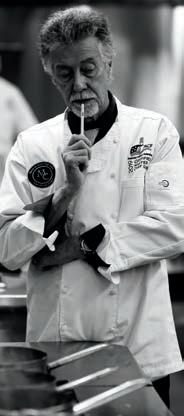
n e ws Byte
ACF's Online Learning Center (OLC) is now available! The digital portal offers opportunities to enhance your skills, advance your career and maintain your ACF certification. Beekeeping classes, NCR and Ingredient of the Month quizzes, nutrition and safety and sanitation courses and written certification practice exams are all now just a click away.
Coming this fall to the OLC is Conference On-Demand, where “attendees” can watch recorded sessions from ACF events and earn CEHs. Get started at acfchefs.org/learn.
10 ncr | m ay/June 2019 | News Bites |
The ACF and NCR salute our newest certified chefs. For the full list, visit wearechefs.com
19
Percentage of food service workers who have used illicit drugs in the past month, highest of all 18 occupations polled
Source: SAMHSA, Center for Behavioral Health Statistics and Quality, National Surveys on Drug Use and Health (NSDUHs) 2008 to 2010 (revised March 2012) and 2011 to 2012
past mental health issues. The top 3 issues reported were Depression, anxiety, and substance abuse, with 73% reporting suffering from multiple mental health conditions
94%
Source: Survey, Chefs with Issues, in collaboration with the Heirloom Foundation
1 in 5 adults in America experience a mental illness.
Source: National Alliance on Mental Health, 2018
–Bonnie Horgos in her article “Sobriety Made Me a Better Cook, and Cooking Keeps Me Sober” (The Kitchn, April 2019)
wearechefs .com 11 | Advocacy | Mental health resources for chefs: 1-800-273-8255 National Suicide Prevention Lifeline 741741 Crisis Text Line (free crisis
big-table.com thegivingkitchen.org
intervention via SMS message)
bensfriendshope.com chefswithissues.com
" "
–Patrick Mulvaney, chef at Sacramento’s B&L Restaurant, on why he decided to host a series of mental health first aid trainings to help restaurant workers learn the warning signs for suicide (NPR, February 2019)
We are storytellers at the end of the day. And one of our stories is going to be about mental health.
–Mickey Bakst , general manager of Charleston Grill and co-founder of Ben’s Friends, at ACF ChefConnect: Minneapolis in April, discussing his addiction before he was found near death from an overdose in 1982, putting him on the path to sobriety
" n obody said, ‘Don’t you think it’s too much?’ all of a sudden one day it turned to hell. Absolute hell. ”
"[O]nce you learn to take care of your body, cooking transcends just filling the tank."
[of culinary workers surveyed] reported having current or
–Matt Basile , in his article “The Crazy Life
of a
Chef Is Nothing to
Celebrate”
(Munchies, March 2015)
“As food professionals, we need to recognize that ‘that's just the way it is in our industry’ isn't a viable response anymore.”
Einav Gefen, executive chef at Unilever Food Solutions, discussing FairKitchens’ goal of empowering chefs to create a new kitchen culture (We Are Chefs, January 2019)
“The last thing you want is a chef, or someone else, who’s not fully functional in the kitchen, because at the end of the day it impacts the executing.”
Beef. Is It Still What’s for Dinner?
The average American consumed 57.2 pounds of beef last year. That’s down 15 percent from 2000, when we ate 67.5 pounds each.
Beginning this year with a slight increase from 2018, consumption is forecast to vary annually between 58.4 and 59.7 pound for the next 10 years according to Statista. While that extra pound or two over last year is good news to beef producers, year over year growth over the next decade will be minimal to none. And the drop in consumption of roughly the weight of a gallon of milk within the span of one generation since the turn of the century is significant.
Shunning animal products and byproducts — at least some of the time
— is more mainstream than ever, evidenced by such meatless menu introductions last year as the plant-based Impossible™ Slider at Columbus, Ohio-based White Castle and The Beyond Meat Cheeseburger offered at Dallas-based TGI Friday’s units nationwide.

Beef (and all red meat) was dubbed “bad” in the health craze of the 1980s and early ‘90s when the focus was on reducing fat — especially saturated fat — in the diet. Times have changed dramatically, and today most experts agree that excessive sugar and simple carbs, not dietary fat, is what ails us. Meanwhile, many nutritionists warn about consuming one or two food groups exclusively while ignoring others. As Julia Child famously advocated, moderation with all foods is key. But a growing number of consumers view beef with less concern about health and more about cattle-raising’s impact on the environment.
A 2006 report by the Food and Agriculture Organization (FAO) of the United Nations, “Livestock’s Long Shadow,” states “the livestock sector is a major stressor on many ecosystems and on the planet as a whole. Globally it is one of the largest sources of greenhouse gases (GHG) and one of the leading causal factors in the loss of biodiversity, while in developed and emerging countries it is perhaps the leading source of water pollution.”
Americans are increasingly concerned about their own impact on the earth. As they embrace more sustainable habits and customs in their daily lives, they’re expecting the same from companies they buy from, including restaurants. From compostable straws to upcycled food scraps, more diners depend on restaurants to draw on environmentally friendly business practices. These same diners are gauging environmental responsibility when choosing where they eat.
12 ncr | m ay/June 2019 | Main Course |
The amount we consume has decreased thanks largely to the “plant forward” movement — which doesn’t necessarily mean going meatless.
|
By Brent T. Frei
p hoto credits: a bove: n ational m ango Board; opposite: i n h arvest, i nc.
Above: One-bite chipotle-mango meatball hors d’oeuvres Opposite: Chef Michael Holleman’s plant-forward hash extends traditional diced corned beef with heirloom whole grains, buckwheat groats and flax seeds.
According to Mintel’s 2019 report on foodservice trends, 46 percent of consumers say environmental responsibility is an important factor in their food choices. Indeed, sustainability will become the new normal and operators will need to take more innovative steps to stand out, Mintel says.
Still, beef remains fundamental to American foodways. When the National Restaurant Association’s annual What’s Hot survey polled 650 ACF chefs to identify food and restaurant trends in 2019, it found that fully two-thirds of respondents were equally excited about veggie-centric (“plant forward”) cuisine and new cuts of beef such as oyster, Merlot and Vegas Strip steaks. (Slightly less cited plant-based sausages and burgers as a top trend.) Clearly beef isn’t disappearing from the plate anytime soon and even has the power to enhance menu interest and value of the dining experience.
Chef Michael Holleman, chair of the culinary advisors to the Whole Grains Council, part of Boston-based Oldways (which helped create the Mediterranean

Diet Pyramid in 1993), supports the survey’s findings. “The plant-forward movement is not about creating more vegans and vegetarians,” he says, “but simply encouraging Americans to eat more foods from the soil for improved nutrition and a healthier ecology. That seems to be the demand more than going meatless completely.”
Having one’s cake and eating it, so to speak, is also the goal of the Redwood Shores, California-based Mushroom Council, which conceived of The Blend — extending ground beef in burgers and other dishes by replacing some of it with U.S.-grown mushrooms — with the support of The Culinary Institute of America. Since 2015, the Blended Burger Project in partnership with the James Beard Foundation has encouraged restaurants to put a unique spin on “blended” burgers and menu them between Memorial Day and July 31.
wearechefs .com 13
Brent T. Frei is principal of Frei & associates, Schaumburg, illinois.
Pour ‘em o n
Middle eastern sauces find their way onto diverse menus
By lauren Kramer
One only needs to sit down in a few restaurants to notice a trend on the upswing: the proliferation of Mediterranean food. Interest in Middle Eastern foods in particular is on the rise, particularly among young consumers, according to research by Technomic. “Some 27 percent of consumers say they find Middle Eastern foods and flavors appealing, including 39 percent of consumers ages 18 to 34,” says Lizzy Freier, Technomic spokesperson. “Using sauces and spices is one of the top ways we’re seeing Middle Eastern flavor elements incorporated on restaurant menus.”
Those sauces include tahini, which is made from sesame seed paste; labneh, a strained, Greek yogurt-based sauce; and toum, a garlic and olive oil sauce.

“We’re heavy on all of those sauces,” says Grace Ai-Najm Shea, owner of the Lebanese Taverna, with 11 locations in the D.C. Metropolitan Area. The fast casual restaurant has been around four decades and sells many of its sauces in its marketplace. “Forty years ago no one even knew what hummus or tahini were, but things are changing fast,” she said. “In so many restaurants, you’re
seeing blurred lines when it comes to the ethnicity of a particular food or sauce.”
learning l abneh
Labneh is a versatile sauce that can be used as a dip or as an accompaniment to a main dish. Colonie Restaurant in New York City menus its lamb belly with labneh, while The Meatball Shop in New York uses a tahini and cilantro dressing on its spicy roast cauliflower. “It has a nice, rich, thick consistency, and it takes on the flavors of whatever you want to use it for,” Shea says. “We love the versatility of labneh and its mild base, which allows you to add different spices and herbs.”
Lebanese Taverna places a smear of labneh on the plate with its fried meatballs, but also recently used it in cheesecake. Sassool Mediterranean Cafe, a family owned business with restaurants in Raleigh and Cary, North Carolina, pairs labneh with its kibbeh, a layered ground beef patty filled with bulgar, pine nuts, onions and spices. “We also serve it in a ramekin with stuffed grape

14 ncr | m ay/June 2019 | On the Side |
Above, from top: Falafel and chef's platter at Lebanese Taverna Opposite, from left: Sassool's tzatziki sauce
leaves, and when we make mjadarah, a rice and lentil dish with caramelized onions, we mix it in there too,” says Simone Saleh Lawson, co-owner. “The creaminess of labneh makes for an outstanding flavor combination and can be used as sour cream would, to top soups, add to wraps or burritos and use as a base in a creamy dip, hot or cold. The flavor is similar to sour cream, but so much more.”
Tantalizing Toum
Consisting of pure whipped garlic with olive oil and salt, toum has a mayonnaise-like consistency and a deliciously buttery, garlic taste. While there’s a definite skill to making it, get it right and you have a killer sauce destined for popularity.
Zaytoon Lebanese Cuisine in Santa Barbara, California, menus its chicken schnitzel with toum, while Nicholas Restaurant in Portland serves it with its kafta kebabs. Sassool whips up 80 pounds of toum daily and its diners purchase large tubs of it to take home. “We serve it in a ramekin with all our grilled kebabs, but we also use it in our marinades, salad dressings — we do everything with it,” Lawson says.
While the ingredient list for toum is small, making the sauce is more complicated because it’s very time sensitive. Lawson explains: “You grind the garlic and salt in a food processor and slowly add droplets of olive oil. But if you add the olive oil too fast the garlic breaks, and it turns into a scrambled egg-like consistency. So you need a lot of patience to make this.”
Tahini Tales
Tahini, the best known of the three sauces, shares the characteristic of versatility with toum and labneh. A mix of garlic, lemon, salt and sesame seed paste, it has a creamy consistency and works well with beef, fish, falafel and salad. “It’s the perfect,

citrusy, nutty dressing for falafel and beef or lamb shawarma,” says Lawson, who imports her tahini paste directly from Lebanon and blends it before serving.
Tony Biggs, director of culinary arts for Certified Angus Beef, worked previously as a private chef for the King and Queen of Jordan. “We used tahini all the time — on kebabs, grilled meats, burgers and salad dressing,” he said. “It also works well as a dip for vegetables.”
Parallel Restaurant in Toronto calls its tahini “sesame butter” and makes it on-site by grinding sesame seeds from Humera, Ethiopia in a special mill. A menu favorite is the tahini smoothie with banana, nuts and dates, and diners can purchase tubs of tahini in regular, smoky and beet flavors to go. “We made these products to highlight the simplicity and depth that sesame butter can add to any dish or cuisine,” the Ozery brothers, who own the restaurant, said in a statement. “There are few ingredients as versatile, nutritious and tasty as sesame butter and we find it works great in hummus, mixed into a dressing, spread on a sandwich or baked in a pastry.”
lauren Kramer, an award-winning writer based in Vancouver, British columbia, is passionate about gourmet food and delights in tasting it and writing about it.
wearechefs .com 15
Visit WeareChefs.com for recipes from Lebanese Taverna.
Khachapuri, pronounced “kachaPOR-ay” and short for Adjaruli
Khachapuri, is the boat-shaped, Georgian cheese bread we’re hearing more about — and drooling over — these days. The irresistible combination of chewy and open-faced bread stuffed with salty cheese and topped with extra melted butter and a runny egg is just waiting for the slash of your fork.
The national dish of the Republic of Georgia, khachapuri is traditionally made by shaping leavened bread dough into an oval with raised sides, brushing it with an egg wash and filling it with sulguni, a brined cow cheese, before baking until browned and topping it with that just-cooked egg. One eats such a treat by ripping off pieces of the crusty-edged, slightly sweetened bread and dipping them in the rich and liquidy center. In Georgia, one might also see the cheese bread served with boiled eggs and potatoes.

According to Datassential, 45 percent of consumers say they want to try it, though only 14 percent have. That might be because while khachapuri has historically only been found at more traditional Georgian restaurants, more chefs seem to be experimenting with the
Say Cheese
dish as part of a modern exploration of ethnic cuisines and with the knowledge that Instagramming diners will likely whip out their smartphones for this one. The slowly-growing obsession with khachapuri also falls on the heels of a growing consumer awareness of Georgian wine, which follow some of the oldest (and more natural) wine-making traditions of the world, including that of Italy.
Khachapuri can be found on the menus at the Michelinstarred modern Georgian restaurant Supra in Washington D.C., as well as at Toné-Café and Georgian Dream in Brooklyn; Old Tbilisi Garden in NYC, Bevri in Palo Alto, California, and at Kargi Gogo in Portland, to name a few. Chef John Paul Damato of international street food concept Compass Rose Bar + Kitchen in Washington, D.C. has had khachapuri on his menu for some time now — even celebrating the sale of its 10,000th order in 2015. He uses a combination of feta, mozzarella and ricotta cheeses to mimic the naturally salty, creamy and gooey nature of traditional sulguni, and he perks his version up with extra locally-sourced butter and a sprinkling of za’atar.
Georgian Dream offers three versions of khachapuri adjaruli: the boat-shaped one with a raw egg yolk and a knob of butter that diners stir up at the table before dipping; and khachapuri megruli, which comes with the egg already mixed in. Imeruli khachapuri has two layers of dough with an extra helping of sulguni cheese inside that’s then baked to browned perfection for extra cheesy-chewy goodness.
Chicago-based Crepe Bistro’s khachapuri comes with a blend of feta jack and cheddar cheeses as well as a topping of tomatoes. And at Kachka in Portland, the cheese is wrapped up more like a calzone.
Either way you make or serve it, khachapuri seems to tug on Americans’ heartstrings for pizza, and as restaurants continue to capitalize on non-dinner dayparts like all-day breakfast and brunch, this menu item makes for a real winner.
a mericans’ desire for gooey, buttery, cheesy bread is like energy — it never dies, it only changes form
|
16 ncr | m ay/June 2019 | On the Side |
By a melia Levin
amelia levin is a chicago-based food writer, cookbook author and chef.
















































C M J CM MJ CJ CMJ N AD BASQUE CHEESE 7.375X4.5-01 vecto HD.pdf 1 12/04/2019 09:01
The Gold S Tand ard
An American first-timer’s view of the Bocuse d’Or //
 by Jocelyn Tolbert
by Jocelyn Tolbert
Earlier this year, the Bocuse d'Or, Coupe du Monde de la Pâtisserie and 22 other world class culinary competitions were held in Lyon, France. Sirha, the biannual international foodservice tradeshow, generously hosted NCR on behalf of the ACF. It was an opportunity not to be missed.
every few minutes, whoops and applause rise from another group in the grandstands. They wave flags from their home countries and raise handmade signs. Once in a while, a brass band strikes up a jaunty tune. Someone keeps honking an air horn.
It’s barely 10 a.m. — 4 a.m. at home in Florida. And a simple cup of American coffee is nowhere to be found.
These are the first hours of the Bocuse d’Or 2019 finale, sometimes called the most prestigious culinary competition in the world. It was created in 1987 by the legendary Paul Bocuse as a showcase — and competition — between 24 young chefs from all over the world. Here in Sirha's grand Espace des Chefs, with all eyes on the open kitchens, it’s obvious he succeeded. The grandstands are separated from the row of 12 active kitchens by a “press corridor” and a section where, later in the afternoon, the judging will take place in plain view. Huge projection screens above the kitchens and non-stop commentary from two announcers keeps everyone connected to the action.
The scene at ACF competitions is similar. The chefs work in open kitchens while fans crowd around, only feet away from the action. But there’s nowhere near the same level of raucous enthusiasm. According to the chefs I spoke to, the Bocuse’s atmosphere is unique — and something one can’t really grasp until one arrives in Lyon.
“[At the Culinary World Cup,] people that are walking around — they’re not going to start screaming because they see the cold buffets. Or if they stand in front of the kitchen where the team is cooking in front of the glass, they’re not going to scream,” says Michel Bouit, CEC, AAC, who was in charge of choosing and training the U.S. candidates to the Bocuse d’Or for 20 years. “In Lyon, they give them that.”
Other first-timers were just as impressed — even the group of ACF chefs I talked to, many of whom have seen more than a few competitions before. “All the countries were there cheering. You had people shooting guns off with confetti. Musicians playing. They had everything there,” says Art Ritt, HAAC. “I was surprised how many Americans were in the audience. We sat in a section, there were at least 50 or 75 Americans rooting, and mostly young people.”
“At the Culinary World Cup, you can stand outside the kitchens, and there is
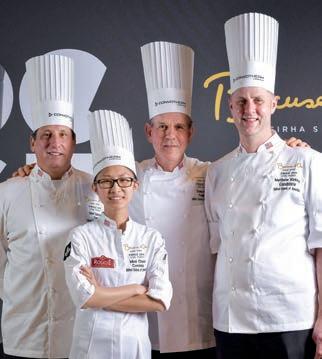

some cheering, but it's not like this. You're surrounded by 2,000 to 4,000 people — it's like a sporting event,” says Ted Polfelt, CEC, CCA, AAC. “You don't see that kind of following at other culinary competitions. Every other team had bands and drums. It was cool to feel that energy.”

The cluster of American fans was indeed a surprise. When Mathew Peters and Harrison Turone brought the gold to our shores for the first time in 2017, the Bocuse barely registered on U.S. radars.
One only need look at our TV-watching habits to know that we love a good cooking competition. But if you talk to most Americans — other than those proudly hoisting the stars and stripes in the front row — they probably wouldn’t know much about the Bocuse d’Or or other high-level competitions such as IKA or the Culinary World Cup.
“I may be wrong, but I don’t think American culinary fans are quite there yet,” says

wearechefs .com 19
Above: American fans in the grandstands Right, above: (from left) Coach Robert Sulatycky; commis Mimi Chen; Thomas Keller, 2019 Bocuse d'Or judge and president of the Ment’or BKB Foundation; head chef Matthew Kirkley
Below: Kirkley preparing his rack of lamb for the platter presentation
Unlike “Hell’s Kitchen,” the Bocuse d’Or isn’t televised, which is a big roadblock to entering the American cultural consciousness. While one announcer was speaking English, the rest spoke French — also a hard sell to American audiences.
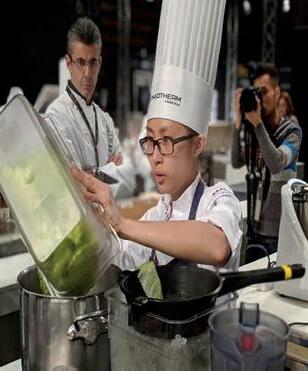
Some believe that food is written into European culture in a way that it just isn’t in the United States — at least not at the same level.
“We’re not a dining culture. … It’s not woven into the fabric of our lives,” says 2019 U.S. team coach Robert Sulatycky. “When a Frenchman wakes up in the morning he thinks, ‘What am I having for dinner?’ … And at home, I don’t think we think that way.”
“[France] is my favorite country in the world because it’s very foodcentric. It doesn’t take long to look around at the streets and roads and cars and see it’s just value system,” says 2019 Bocuse d’Or head chef Matthew Kirkley. “Day-to-day pleasures matter
more than … possessions. And I’m not saying one is better. It’s just how you spend your money.”
Marie-Odile Fondeur, managing director of Sirha, is confident that the European furor for culinary competition will cross the pond eventually. “We’re working hard to promote Sirha and our competitions in the USA but it takes time. However, we have a good network there,” she says. “Jérôme Bocuse lives and works in the USA, we are very close to famous chefs like Daniel Boulud or Thomas Keller. So, it will take time, but we’ll make it, I’m sure.”
Back at the Bocuse in 2019, after the chefs have cooked for five hours and 35 minutes, the presentation of the plates and platters begins. The crowd is going wild. The plates are paraded in front of the media — now relegated to the press corridor, behind a large partition — before being sliced with breathless announcer commentary and served to the judges who have taken their seats in front of the kitchens, facing the audience.


When the American team’s plated vegetable chartreuse with cockle butter and roast rack of veal with veal kidney farce,
Denmark's winning "Mother Nature"-themed plate with chartreuse, Romanesco with caramelized scallops, green apple and tarragon with smoked cheese, egg yolk leather, Vesterhavs cheese cockels, puntarella and Flora Danica. Left,

20 ncr | m ay/June 2019 | Management |
Barry Greenberg, CEC. “I don’t think this level of cooking is going to attract the same audience as ‘Hell’s Kitchen.’”
from top: Commis Mimi Chen hard at work; Kenneth Toft-Hansen after winning the 2019 Bocuse d'Or
apicius spice glaze and salad pastorale (pictured below) appears on the projector screen, there’s an audible gasp throughout the stadium. It’s beautiful — a culinary puzzle topped with the tiny, stamped flower-shaped pieces I’d watched commis chef Mimi Chen labor over. The dish doesn’t need to be cut, only deconstructed. One commentator says it’s “amazing trickery and very smart because cutting is a very difficult part.”
“There were oohs and ahhs from everybody, and there was nothing to cut. It was so unique in comparison to everybody else’s. And I thought that alone would have put them over the top,” Ritt says. “I was disappointed they only got ninth.”
Spoiler alert.
Yes, at the awards ceremony the next night, the American team received ninth place. Thirty-seven-year-old Toft-Hansen took home the gold Bocuse statue as the contest’s 2019 winner. It was Denmark’s second win in history. The Danish fans in the crowd completely lost it. Confetti was everywhere.
The next day, even though I’m exhausted and my feet are sore from getting repeatedly lost in the staggering 1,506,947 square feet of trade show (“Every day is like, which way is the way out?” laughs Polfelt), I’m feeling energized. I’m not alone, either.
“From my spectator’s vantage point, I found myself inspired creatively as well as professionally,” says John Schopp, CEC, CEPC, CCE, CCA, AAC. “ This will be a bi-
annual Mecca for me and as many people as I can convince to join me.”
“I’d love to take my wife and my students or other chapter members,” Polfelt says. “It’s just a plane ride. It’s so important to travel and see how close everything is. Travel influences the way we see people and the way we cook.”
If all of these first-timers are so enamored after one visit to Lyon — and ready to convert their friends, family and students into Bocuse d’Or disciples — then perhaps high-end culinary competitions like the Bocuse, IKA and the Culinary World Cup do have a place in mainstream American culture. In fact, IKA is in February 2020 and both the ACF Culinary National Team and the ACF Culinary Youth Team will be competing in Stuttgart against the best in the world.
“America’s in its adolescence culinarily and we continue to grow,” Kirkley says. “But it’s going to take some time.”
Read more of this story and see more photos on wearechefs.com .

wearechefs .com 21
Fasting, then Feasting
By Robert Wemischner
Across the vast expanse of the Islamic world, fasting from sunrise to sundown during the month of Ramadan — one of the five principal tenets of the faith — is a common thread. But from north Africa to the Middle East and southeast Asia, “fasting” naturally leads to “feasting” and there is plenty of that at the end of each day with foods that vary widely from country to country. It’s a rich and colorful tapestry of tastes and textures that might be emulated in your own cooking.
In the varied cuisine of Iran, for example, savory porridges called aush made from legumes and rice are eaten as a staple during the Ramadan fast. Going west to Oman, spicy skewered meats and fritters of all kinds break the daily fast. In desert countries, dates, with their high sugar content, provide a quick boost of energy and are often a food of choice. The prophet Muhammad urged the fasting faithful to turn first to the rich desert
fruit, a tradition that holds true today in much of the Islamic world. Many sweets served during this time are enriched with fillings made from the more than 1,000 varieties of dates.
Ask Najmieh Batmanglij, the author of many books on Persian cuisine, about her traditions and she will regale you with stories (and recipes) from her months-long return journey through modern day Iran after 40 years of living in Washington, D.C. The trip led to her latest book, “Cooking in Iran: Regional Recipes and Kitchen Secrets” (Mage Publishers, Inc, 2018). Here she offers a few specialties she encountered there that are traditionally served during Ramadan. From lacy rice pancakes with a rosewater and cardamom syrup in the part of Iran bordering the Caspian Sea and the seeded yeast bread from the far northwest of the country to the sweetened rice cake of Mashhad made in the opposite corner of the land, there are many nourishing foods that surface at this important time of the year.

22 ncr | m ay/June 2019 | Management |
p hoto credit: m age p ublishers
Above: Wheat and Turkey Breakfast Porridge/ halim-e gandom Opposite, from left: Green Herb aush/aush-e sabz-e shirazi; Rice pudding/shir berenj
Morocco has its harira, a fastbreaking soup with legumes including chickpeas and fava beans, onions and tomatoes (meatless or not, depending on the region), and a generous helping of herbs — mainly cilantro and parsley. Likewise, Batmanglij points to another kind of dish, a green herb aush she experienced at a street vendor’s stall. A mix of legumes and rice cooked in a broth made from lamb shank and neck is flavored with a generous bouquet of fresh herbs including basil, chives and tarragon used to brighten the dish which fortifies after a day of fasting.

She recalls her childhood experience of Ramadan as a time of festivity and notes: “By fasting, one concentrates less on food and materialism and gives the body a month’s rest to detoxify.” Finish the meal on a sweet note, she says, with
rice pudding (shir berenj), a dessert common to many of the world’s cuisines but in Iran is flavored with rose water and cardamom.
Whether celebrating festive times of the year or not, the multilayered, complex flavors of the foods from this part of the world would make a welcome addition to menus on which Mediterranean cuisine is celebrated. Adopting ingredients used in the cuisines of Iran, Syria, Morocco, Arabian gulf countries, Indonesia and elsewhere translates to vividly flavored food that could find a place on your establishment’s regular rotation.

wearechefs .com 23
robert Wemischner is a longtime instructor of professional baking at los angeles Trade Technical college and the author of four books including The Dessert architect and cooking With Tea. he also teaches a course in restaurant management.
Classical
A family legend told by salad dressing mogul Rosa Cardini begins on Independence Day 1924 in the busy kitchen of Caesar’s restaurant in San Diego. Cardini’s father, Caesar, was running low on ingredients, so he “decided to cobble together a salad from leftovers, including romaine lettuce, olive oil, raw egg, garlic, Parmesan cheese and Worcestershire sauce. The dressing was originally mixed at the table and used to coat the lettuce leaves, which were presented stem outwards so that it could be eaten with the fingers, in the time-honoured Italian fashion,” according to Rosa Cardini’s 2003 obituary in London’s The Telegraph.
The new dish was named for its creator, and became quite popular in Hollywood as well as around the world. “In 1953, a toque of Paris's leading chefs pronounced it to be America's greatest contribution to world cuisine, a judgement of which Rosa Cardini was very proud.”

24 ncr | m ay/June 2019 | Classical vs. Modern |
Modern
“Classic Caesar salad has been around for so long, there’s lots of interpretations,” says Carrie Summer of Chef Shack in Minneapolis, Minnesota and Bay City, Wisconsin. “I love that it has a classic fabled history including a tableside version.”

Summer wanted to transform that classic recipe into something high-end and sophisticated — something that would have all the flavor and elements of a Caesar salad, but look more like a dessert. “The modern look was quite tight and compact with less on the plate,” she says. A Parmesan frico tops the careful plating while a dollop of Caesar dressing on the side finishes the look.
See the classical and modern recipes, as well as more photos, at wearechefs.com.
wearechefs .com 25
p hotos by e liesa Johnson
More and more, officials at the top of every industry are being asked to answer a tough question: Why doesn’t the company executive team reflect the many faces of its employees or the constituents it serves?
By Jody Shee
26 ncr | m ay/June 2019

wearechefs .com 27 p hoto credit: h ea ther Blackwell
Diversity
D o esn’t
In ways, restaurants have championed diversity more than other industries simply because they have always hired from the diverse pool of employees in the neighborhoods they serve, according to Edward Lee, chef/partner/owner of three restaurants in Louisville, Kentucky and two in the Washington D.C. area. “We already have diverse environments, but not equal environments. Diversity doesn’t always equal equality.”

Some 47 percent of restaurant employees are minorities, compared to 36 percent in the overall U.S. labor force, according to the U.S. Census Bureau’s 2015 American Community Survey. But up the ladder of success, the winners begin to look more and more similar.
“Most industries in the U.S. for generations, and mainly in creative fields, have been dominated by people with money and power, and those people tend to be of one culture and tend to be men,” Lee says. Thus, media attention, awards and resulting funding for the next project have not been equally distributed to women and minorities, making success more difficult.
Clear benefits
Diversity in boardrooms and on committees makes good business sense. According to McKinsey & Co.’s “Delivering Through Diversity January
2018” report, companies in the top quartile for gender diversity and those in the top quartile for ethnic/cultural diversity on executive teams were respectively 21 and 33 percent more likely to have industry-leading profitability.
That’s because gender and ethnically diverse teams are more creative, productive and more capable of finding solutions to difficult tasks, says Gerry Fernandez, president and co-founder of the Multicultural Foodservice and Hospitality Alliance, Providence, Rhode Island.
“The most important aspect of diversity is thought, perspective and experience,” he says. “To illustrate, you wouldn’t put plumbers in a room to make the decisions for electricians and architects.”
The growth of diversity in the workplace was predicted decades ago by observing the population census data, which has long shown faster minority growth and lower growth among whites, Fernandez says. “If the population is more black, brown and immigrant, the workforce has to go the same direction.”
As a younger, more multicultural generation comes into power, both as
28 ncr | m ay/June 2019
“
A LWAyS eq UA l eq UA l ity.”
p hoto credits: a bove: e dw ard l ee; opposit e: u S Foods
Above: Lindsey Ofcacek and Edward Lee of The LEE Initiative Opposite, left: US Foods’ Sarah Tymkiw was among the company’s delegation of women to attend the WFF Annual Leadership Development Conference in 2018. The company gives each of its attendees an orange scarf to help them identify each other at the conference.
consumers and as employees, they are demanding inclusive cultures. Add to that the current low unemployment rate, and employees will leave a company quickly in favor of a more inclusive one down the street that better meets their ideals, Fernandez says.
intentional efforts
Well-thought-out and orchestrated diversity and inclusion programs emerging throughout the industry could turn 2019 into the year that moves foodservice toward measurable improvement. Operators, suppliers and contract management companies have all stepped up.
Foodservice distributor US Foods, Rosemont, Illinois, with 25,000 employees, has sent women to the WFF Annual Leadership Development Conference for the past seven years and


with the executive team what inclusion looks like at their level. It compared its diversity numbers with other companies and implemented Respectful Workplace training by a third party that includes foundational information, a code of conduct and an official company policy. Already 1,200 directors and above have participated in the training, and in 2019, the rest of the employees will participate.
Employee resource groups are part of US Foods’ new grand plan. The company asked affinity groups to come together, form a leadership team and devise a team mission to include plans for self-development as well as community outreach. Eight groups came out of the process (women, blacks, Latino/Hispanics, Asians, veterans, generational, LGBTQ and administrative professionals). Each group has an
even holds meetings there for its women a day ahead of the official conference kickoff. But recently, the company has developed a more formal journey toward diversity and inclusiveness with a new strategy and roadmap, says Alyson Margulies (pictured above), vice president of talent management and organizational effectiveness.
The company recently brought in external thought leaders to discuss
executive sponsor from the senior leadership team along with an activity budget, Margulies says.
Contract management company Sodexo, Gaithersburg, Maryland, has a similar affinity group program with nine teams called business resource groups. Theirs are similar, but also include Native Americans and those with disabilities. These groups all have guidelines, clear leadership and
wearechefs .com 29
governance and are platforms for professional and business development and community outreach, says Rohini Anand (pictured below), senior vice president, corporate responsibility and global chief diversity officer.

In the U.S. and Canada, Sodexo has 160,000 employees divided among 13,000 client sites. To ensure that diversity and inclusion reach to the unit level, the company has a suite of training available to each, and the topic is frequently addressed in the Daily Huddle. Before the start of work, the general manager of each location holds a 20- to 30-minute staff meeting on any number of topics, Anand says. In three cities where Sodexo has school accounts, the staff receives anti-bullying training, enabling them to address bullying when they spot it.

ProsPeCts for women
Women may be the most glaringly under-represented group in the upper ranks of foodservice. Initiatives to change that are popping up all over the industry.
By 2025, Sodexo intends for women to represent at least 40 percent of its senior leadership staff globally. Currently that number is at 33 percent. To ensure that all senior executives understand the value of reaching that
ALMOST h A l f of cUlinAry SCHOOL gr A DUAt es A r e wo M e n, BUT
O NLy ABOUT 6 or 7 percent of exec U ti ve chefs A r e wo M e n
goal, 10 percent of their annual bonus is impacted by their progress toward meeting it. “Diversity means a more innovative outcome. If you surround yourself with only like-minded people, you get variations of the same,” Anand says. Sodexo is one of 230 companies selected for the 2019 Bloomberg Gender-Equality Index, which distinguishes companies committed to transparency in gender reporting and advancing women’s equality.
The James Beard Foundation, New York, has had a women’s entrepreneurial program for six years. It recently shifted the program from internships to identifying and paying for 20 women chefs from around the country to attend a week of programming at entrepreneurship-focused Babson College in Wellesley, Massachusetts. The curriculum includes such topics as how to read a profit-and-loss statement, dealing with human resources, how to create
InclusIon as a cause
Cause-focused Millennials and GenZ have changed the way companies approach business, including marketing and the things they care about and support. “They see that Starbucks is good to the planet, and they believe climate change is real,” says Gerry Fernandez, president and cofounder of the Multicultural Foodservice and Hospitality Alliance based in Providence, Rhode Island. “They know that for their future, they have to worry about important causes.”
As a fact of life, diversity isn’t something these generations talk about, but inclusion and equality are, he says. Therefore, a brand’s image and marketing must demonstrate inclusiveness.
Some of the most authentically communicated causes spawn organically from an operator’s personal experience. Michaela Mendelsohn, transgender owner and chief executive of Pollo West Corp., Agoura Hills, California, is among the National Restaurant Association Educational Foundation’s 2018 Faces of Diversity, Restaurant Neighbor and Ambassador of Hospitality award winners. In her position as an El Pollo Loco franchise owner, she ensures that transgender/gender non-conforming individuals have the opportunity to succeed. She has hired more than 40 transgender employees, and a quarter of them have risen to management positions, she reported in an opinion column in the Washington Blade. She created the organization TransCanWork.org, “a group of educators and program navigators committed to advancing workplace inclusion through innovative training strategies and workforce development,” according to the website.
Similarly, Eduardo Garcia is a champion of disabled individuals. After years as a chef, including serving as a private chef in the yachting industry, he was transitioning to building MontanaMex, a Boseman, Montanabased grocery brand that makes organic and non-GMO condiments for consumers and the foodservice industry. In October 2011, he was electrocuted and lost his left hand and half of his forearm. “It rocked our world. We nearly closed the company,” he says. But he overcame, and with a prosthetic arm and a re-tuned outlook, he’s been able to turn his disability into a spotlight to help others with disabilities and challenges. His company partners with the charitable organization Challenged Athletes Foundation, which sponsors triathlons and bike races throughout the U.S. for physically challenged individuals. MontanaMex supports the foundation through donations and by setting up tents at a few of the events throughout the year offering food samples to participants.
“From our point of view, we are a brand that wants to bring full, satisfying enrichment to the human experience with clean, organic, healthy tasty food. So, it’s kind of a no-brainer in today’s day and age, it should be in the DNA of every company to have an everyday practice of asking ourselves what we do to help our fellow man around us,” he says.
To inspire others and spread his positive message, he produced an 86-minute documentary, “Charged: The Eduardo Garcia Story.” He will be a keynote speaker at the American Culinary Federation National Convention in August in Orlando, Florida.

alternate streams of revenue and more, says Mitchell Davis (pictured opposite left), chief strategy officer. The program already has 40 program alumni.
Davis points out that almost half of culinary school graduates are women, but only about 6 or 7 percent of executive chefs are women. “Somewhere between an equal beginning and the top of the career,
wearechefs .com 31
Above: Eduardo Garcia’s disability is part of his platform to spread good along with his MontanaMex brand of organic and non-GMO condiments for consumers and the foodservice industry.
p hoto credits: o pposite, from top left: James Beard Foundation, Sodexo; above: e duar do Garcia
we lose almost 100 percent of women. We’re trying to find a way to support them in the beginning, middle and end of the career they have checked out of,” he says.
From its women’s entrepreneurial program revision, last year the association launched a smaller-scale local program called Owning It, bringing lessons from the larger national group to major cities to not only cover important business topics, but to create a women chef network in those cities.
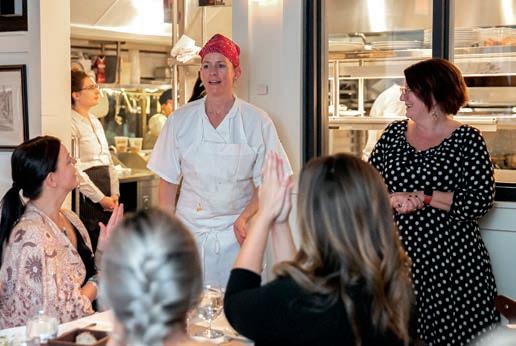

In his own region, two years ago restaurant owner Lee set out to make a difference by creating a path to success for minorities. He co-developed The LEE Initiative, a 10-month intense mentorship for five women at a time from Kentucky and the surrounding area, not only to immerse them in all things
culinary but also in entrepreneurship. His goal is to create the next generation of leaders, chefs, owners and activists. “When it’s their time to be the next great chefs and owners, they will understand that success financially alone isn’t enough. They need a form of activism on whatever the issue of the day is. They will take it head on. Success is not selfish, it’s communal,” Lee says.
He hired Lindsey Ofcacek as managing director and co-founder of The LEE Initiative. She also serves as wine and beverage director for Lee’s 610 Magnolia, Louisville, Kentucky. “I’ve been in the restaurant industry for 20 years in almost every position front to back of the house,” Ofcacek says. They settled on the women’s focus as they pondered what they could do to counter the restaurant industry sexual abuse atrocities.
Lee and Ofcacek look for five women who have been in the industry for two to three years who plan to become an executive chef or owner. Among their opportunities, they spend two weeks paired with a successful woman chef somewhere in the country to mentor them. They spend time at a local smallbatch bourbon whiskey producer as well as a local artisan ice cream company. They also receive media training with Wagstaff Worldwide and cook dinner at the James Beard House. This year they will attend the FAB Symposium in Charleston, South Carolina, for two days of educational and inspirational workshops taught by and for women in the hospitality industry.
While the program is small, Lee hopes it will serve as an example. “If others see what’s happening in our community, they can replicate it for their community in their state,” he says.
Jody Shee, a Kauai, hawaii-based freelance writer and editor, previously was editor of a foodservice magazine. She has more than 20 years of foodwriting experience and writes the blog www.sheefood.com.
32 ncr | m ay/June 2019
WIdenIng the Path
Support and mentorship are part of elle Simone Scott’s plan to see women of color achieve parity in the kitchen

 By Jody Shee
By Jody Shee
Elle Simone Scott, TV talent for cooking show
“America’s Test Kitchen,” is also the founder of SheChef Inc., a networking organization for food entrepreneurs, aspiring and seasoned chefs and other professionals working in the food and beverage industry with a special focus on women of color. She will give the leadership keynote address during the symposium "United in Food: Women Leaders of Today and Tomorrow" at the ACF's National Convention in August in Orlando, Florida. Here she offers her views and experiences regarding inclusion and equality in the foodservice industry.
Q. What was your path into the foodservice industry?
a Years ago, to supplement my income as a social worker, I worked in garde manger alongside immigrant ladies, learning their cultures’ preparation methods. When my social work job ended, I found an opportunity to cook on a cruise ship where I fell in love with the foodservice industry, long hours and all. I became a member of Women Chefs & Restaurateurs (WCR) and received a scholarship to attend the French Culinary Institute in New York. It was still unaffordable for me, so I opted to attend a trade school, The Culinary Academy of New York. When I interned at The Food Network’s test kitchen, I noticed a lack of cultural representation. After completing my internship, I sought out women of color from my school to continue the test kitchen internship program — always with an eye for those who would pay it forward by providing similar opportunities when they were in the position to do so.
Q. Was there a specific time or event in which you personally experienced inequality in foodservice?
a. Social inequality wasn’t my reality until some time into my career when I worked on the production team of a famous New York restaurant group for two years and was asked to train a new man for a sous chef job that I wasn’t even being considered for, and no one stood up for me.
Q. Why is it so difficult to find women restaurant chef/owners?
a. With fewer women chef/owners, there is far less mentorship. The low representation of women in
those successful positions means there is lower visibility. A blueprint for what that can look like is missing. You can’t visualize yourself successful in a role you can’t see. You can only hope you can do it. I think the problem is doubled for women of color.
Q. Is there proof that kitchens are generally male dominated?
a I’ve never encountered a chef, male or female, who has said that kitchen leadership is off limits for women, at least not verbally, so when and how and why it became that way, no one knows. But the restaurant culture is a patriarchal system.
Q. With your sociology background, how did the disparity strike you?
a. I wanted to investigate, and I discovered that culture and ethnicity combined with uniqueness of the restaurant industry has contributed to low representation of women and women of color, who sometimes are responsible for their whole family. The home dynamics are different. Add to that, the culinary industry has nontraditional hours. And those in service industries aren’t the highest paid individuals, especially the starting pay. And finally, an article in The Boston Globe pointed out that the average annual income of blacks is only a fraction of that of whites.
Q. Describe what you’ve done to help build a bridge for women.
a I started SheChef six years ago, initially as a meet-up group for industry women of color who pulled together to help watch kids for those who worked at night. It was support to help pick up kids from the sitter or borrow culinary school books or chefs coats, etc. It was a support network so women could take gigs or hold a job who didn’t have a support system. It is now a national, multi-tiered organization with more than 200 members. We provide scholarships, internships, annual panel and speaker series and networking opportunities.
Q. Do you have an example you can share of a woman who has developed a successful career in foodservice as a result of your efforts?
a I launched SheChef in 2013 with a huge event. Chimere Ward, who owns Clean Plate Co., a New York catering and prepared food company, walked in the door of the event with her husband and thanked me for what I was doing. I’d only been doing it for a minute. I’ve been her mentor and friend since then, and she has taken every opportunity I set in front of her and gone for every certification I have suggested. She came through Hot Bread Kitchen, a New York incubator kitchen, and provides products in Whole Foods in Harlem and Columbia University’s dining hall in New York. She has catered for the mayor’s and governor’s office. She’s my most successful member to this day.
wearechefs .com 33
Opposite, from top: Carolyn Johnson, chef/owner of 80 Thoreau, Concord, Massachusetts, hosted a welcome dinner for the chefs at the beginning of the James Beard Foundation 2018 Women's Entrepreneurial Leadership program (photo credit: Paige Brown Photography); Lindsey Ofcacek and Edward Lee of The LEE Initiative stand behind the five mentees they selected for the 2018 program. In front, from left, Stephania Sharkey, Jen Rock, AuCo Lai, Nikkia Rhodes and Stephanie Callihan prepare dinner at the James Beard Foundation Beard House.
Above: Elle Simone Scott, founder of SheChef Inc., which focuses on women of color, moderates a panel.
p hoto credits: o pposite, from top: James Beard Foundation, e dw ard l ee; abo ve, left and right: e lle Simone Scott
The hA r D e ST Sh I f T
Restaurants and nonprofits on the forefront of industry culture change to address mental health and addiction concerns
By Samantha Lande
From the outside, the hospitality industry might seem glamorous. Access to amazing food, top shelf booze, a creative outlet. But those in the industry know that it’s not always what it seems.
Drug and alcohol abuse are rampant and mental health issues are fairly common. Hours are long, wages are low, and access to healthcare benefits is nearly non-existent. According to research done by Restaurant Opportunities Centers United, almost 9 out of 10 people who work in the restaurant industry lack paid sick days (87.7%) and health insurance from their employer (89.7%). Many can’t afford to even take the day off to visit the doctor for themselves or their families.
Pfeiffer, chef de cuisine at Blackbird in Chicago holds late night, post-shift “after school demos” where he shows various cooking techniques and then has his pupils face off in a Kung Fu-style competition. Olympia Provisions in Portland is giving out wellness tokens instead of shots and others are hosting group meetings with Ben’s Friends, a regional organization that hosts relaxed meetings for alcoholics.
neeD TO A bA nDon THE CULTURE OF shift Drinks
The good news? The tide is shifting. Those inside the industry are fed up with the way the system is designed. They want to see better hours, fairer wages and access to resources for those struggling. They want health insurance and days off, benefits that are commonplace in other industries. And they want to see a real shift in the culture.
Changing the Culture
Restaurant culture is built for late nights which often means limited options to blow off steam after shift. But restaurateurs are getting creative — Canlis in Seattle is offering late night laser tag in the confines of the restaurant; Ryan
“We need to abandon the culture of shift drinks,” says Mike Thelin, founder of Feast, Portland’s premier food festival. Although Thelin isn’t in the kitchen day-to-day, he’s aware that Feast Portland has an important role in shifting the culture. Festivals tend to be grounds for late night partying and overindulgence. And although there will always be some element of drinking, they want to eliminate some of the excess.
“We want to represent our industry and what is relevant and important to our industry... go out of our way to help celebrate balance and highlight the really positive things,” he says.
Starting next year, they are ending all Feast-sanctioned programming at 11:30 p.m. and will add in wellness benefits for the chefs like guided hikes and fitness classes during the day. This past season, they hosted a “Zero Proof Dinner” with notable
34 ncr | m ay/June 2019 | Health |
“WE
”
sober
offering help
Shifting the culture is the first step, but there needs to be a support system in place as well — both for the restaurants that want to make changes but don’t know how and for those individual workers who are struggling.
Healthy Hospo is based in the UK but recently launched in the United States. The group works with the hospitality industry (and big liquor brands like Bacardi) to change the face of the industry. Founder Tim Etherington-Judge was in the hospitality industry and struggled with depression.
“We shouldn’t be waiting for people to get sick and then provide them with support,” says Etherington-Judge. “We need preventative action to have a healthier, happier more productive industry.”
They offer workshops on important wellness issues like sleep, drugs and alcohol. They create modules specifically for restaurant groups and brands to help with employee needs. They’ve launched yoga classes in London and plan to add additional healthy outlets for those in the industry to appreciate.
Chefs with Issues, started by writer and editor Kat Kinsman, is a virtual space to help those in the industry realize they aren’t alone in their struggles whether it be depression, anxiety, alcohol abuse or drug problems. The site provides a list of solid, vetted resources for help, and the private Facebook group serves as a discussion forum.
Providing the Benefits
Perhaps the hardest shift to make in the industry is offering health and wellness benefits. A few restaurants are starting to see that this expense can be a positive for the bottom line. Josh Kulp and Christine Cikowski (pictured left), owners of Chicago's Honey Butter Fried

Chicken, knew that they wanted to provide health insurance, paid parental leave and sick days to their employees from the start. And although the upfront cost was scary, they’ve seen clear benefits — less turnover, happier and healthier employees and a more diverse workforce. Chicago’s Fat Rice and their other concepts Fat Rice Bakery and The Ladies Room have added a four percent fair wage and wellness provision to provide health insurance to their employees and to help balance out the wage disparity between tipped and non-tipped workers.
“[Employees] having that safety net can really help with some of the mental health challenges,” says Kulp. The duo feels like they are just scratching the surface when it comes to shifting the culture.
Samantha lande is a freelance writer based in chicago. her work has appeared in Food network, chowhound, Time out and other local and national publications.
wearechefs .com 35
chefs from around the country: Andrew Zimmern, Michael Solomonov, Gabrielle Rucker, Sean Brock and Gregory Gourdet.
food as Medicine
There are no mystery meats slathered in congealed gravy, rehydrated mashed potatoes or frozen peas served at St. Luke’s University Health Network (SLUHN). The patients recuperating in the Pennsylvania hospitals are served potatoes, onions, cabbage, beets, cucumbers and other fresh produce grown on the 11.5-acre farm on the Anderson Campus. There, farmer Lynn Trizna plants more than 100 varieties of produce, which are distributed to all hospital kitchens in the 10-hospital network.
“By providing patients with locallygrown organic produce, St. Luke’s is showing a commitment to the environment and promoting the health of its patients and the community,” Trizna says.
A growing number of hospitals are establishing farms like these on their campuses, delivering fresh fruits and vegetables to patient rooms, establishing farm markets and CSA programs, teaching cooking classes and donating produce to their communities.

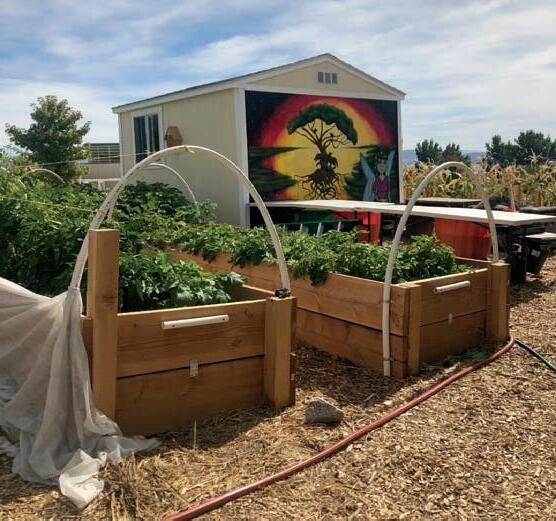
Sharing the Bounty
St. Joseph Mercy Ann Arbor Hospital in Ypsilanti, Michigan, grows 67 varieties of fresh produce on its two-acre farm and sells it through an onsite farmer’s market, community supported agriculture (CSA) subscription and a Produce-toPatients program that provides fresh fruits and vegetables to patients living with diet-related chronic health conditions such as type 2 diabetes.
“It’s one thing to tell a patient, ‘You have diabetes and you need to manage it,’ and another thing to tell them, ‘We’re going to help you and one of the ways we’re going to do that is through lifestyle change and healthier eating; here are fresh vegetables to get you started,’” farm manager Amanda Sweetman explains.
In Pennsylvania, Trizna oversees the operation and works alongside the chefs at SLUHN to choose fruit and vegetable varieties and plan the upcoming growing season — and the collaborations are, well, fruitful.
“[The farm] has had a positive impact on our employees’ eating habits,” Ed Nawrocki, President of SLUHN East Region and Anderson Campus, says. “Growing our own produce has allowed us to discount fresh fruit and salad in our cafeterias and since dropping prices, we have seen an increase in fruit and vegetable consumption.”
Read more about this growing trend on wearechefs.com.
36 ncr | m ay/June 2019 | Health |
Communities are benefiting from the growing number of hospital farms | By Jodi Helmer
Jodi helmer is a north carolina-based food writer whose work has appeared in hemispheres, national Geographic Traveler, Farm life and american Way, among others.
From left: Hoop houses help keep plants warm when temperatures drop, allowing Carson Tahoe Health in Carson City, Nevada, to grow vegetables all year long; Carson Tahoe Health grows more than 700 pounds of produce in raised beds and hoop houses on its farm. All of the produce is donated to local community organizations.
f ull Pl AT e
Pastry chefs have been evolving plated desserts over the past several years — and for several good reasons.
First, the financial part of dessert is really hard. Restaurants are known for razor thin margins, and dessert tends to offer one of the thinnest. To get customers to order more desserts, pastry chefs need use new flavor combinations, apply new techniques, use alternative emulsifiers and, above all, deliver great flavor.
Second, consumers are shifting away from the traditional view of dessert as a post-meal occasion and are increasingly defining dessert as an anytime occasion, according to Technomic’s most recent Dessert Consumer Trend Report .
Third, plated desserts now need eyecatching designs as well as great flavor. According to Aimee Harvey, managing editor at Technomic, social media is one of the seven key food trends for 2019. She writes, “Instagram and other photo-sharing apps have revolutionized the food industry. Restaurants have even created food and beverage with social media in mind.”
By Rob Benes
So how can pastry chefs create a plated dessert worthy enough to increase sales, meet anytime dessert cravings and inspire diners to take and share photos? Here are five pastry chefs who take all of these elements into account.

ryan boya, executive pastry chef, Artscience culture l ab and c afé, c ambridge, Massachusetts
Boya does some interesting things to his ingredients to add layers of flavors and different textures. “Searing, smoking, sous viding and pickling can add subtle elements to elevate a dessert to make it unique and memorable,” he says.
His Scotch and Birch involves using a painter’s wood grain tool to make faux-wood from tempered chocolate. The bark-looking chocolate is filled with dark chocolate and birch crémeux, served with cherry sorbet and garnished with birch beer brownie crumble and smoked butterscotch infused with Laphroaig scotch whisky. The Seared Lemon Cake
Above: Corn Pavlova
wearechefs .com 37 | Pastry |
Pastry chefs are getting creative to inspire customers to open their wallets and pull out their phones.
|
p hoto credits: a bove, Grove Bay h ospitalit y
with Bourbon Apple Butter, Lemon Buttercream, Oatmeal Streusel and Pickled Cranberries includes a lemon pound cake infused with lemon simple syrup that’s seared in a pan with butter, which adds warmth, a crisp exterior, and a soft, moist center.
Jessica scott, executive pastry chef of b arton g, with locations in chicago, new york , and Miami beach, florida
Scott likes to transform savory dishes into something sweet. Take for example her Arancini, where a sweet risotto ball is filled with mango and coated with crumbled orange pound cake. To give the impression of a traditional arancini dish that’s normally plated in a pool of tomato sauce and topped with a basil leaf, she uses strawberry basil consommé with a cinnamon candied basil leaf to garnish.
She also likes to present items that look simple but hide impressive surprises. For example, her Old MacDonald’s Farm looks like a corn cob, but when the customer cuts open the dessert, they discover lemon mousse, lemon curd and Madeleine sponge.
Dallas wynne, stubborn seed , Miami beach, florida
“When plating, I think about how I want flavors to combine,” says Wynne. “I also don’t want to instruct anyone on how to eat a dessert, but I try to place the ingredients in close proximity that go together.”
Her Corn Pavlova is a standout. It includes corn custard, blackberries, honey cornbread, butter gelato, candied corn, kettle corn powder, dehydrated mixed berry powder mixed and

dehydrated lime powder, as well as lime supreme and edible flowers.
phuong “pq” q uach, executive chef at Alexander’s patisserie, Mountain v iew, c alifornia
“People eat with their eyes first,” Quach says, “so desserts not only have to taste good, but they need to look like artwork.”
The London Fog includes Earl Grey tea-infused chocolate mousse, almond joconde, and kumquat and mandarinquat confit. Heavy cream and 1% kappa carrageenan are cooked with Earl Grey for a three-day, twice-steeped process that allows natural sweetness of the cream to come through and counteract the tannins from the tea. The thickened cream is whipped and folded into chocolate anglaise to make the mousse.
The kumquat and mandarinquat confit takes three days to make by cooking the fruit for six hours a day, adding sugar, straining, cooling and repeating. The result is a marmalade-like mixture with a soft set to match with the mousse.

To assemble, the confit are piped into molds and topped with an almond joconde and then frozen. After the inserts are frozen, mousse is poured into a mold, the kumquat/ mandarinquat inserts are pushed into the center and excess mousse is smoothed over and removed. After the mousse has set in the freezer, a blue mirror glaze is poured over.
A spider web effect is achieved by using a white glaze made from pectin
38 ncr | m ay/June 2019 | Pastry |
p hoto credits:
m ichael p
p a tisserie; a rtScience c ulture l ab & c afé
Above, from left: Ross Evans’ Black Sesame Panna Cotta; London Fog Opposite: Ryan Boya’s Scotch and Birch
Spread, left to right:
isarri; a lexander’s
and water, which is a different viscosity than the blue glaze. When the white glaze touches the blue glaze, it disperses to create the design. The dessert is then set on top of a dark chocolate sable and topped with fresh sliced kumquats and chocolate tuile with cacao nibs.
ross evans, executive pastry chef, kuro at the seminole hard rock hotel & c asino, hollywood, florida
Evans’ pastry career is rooted in American contemporary kitchens. When he started cooking at Kuro, he learned about Japanese flavor profiles and textures while applying techniques and methods he mastered over the years.
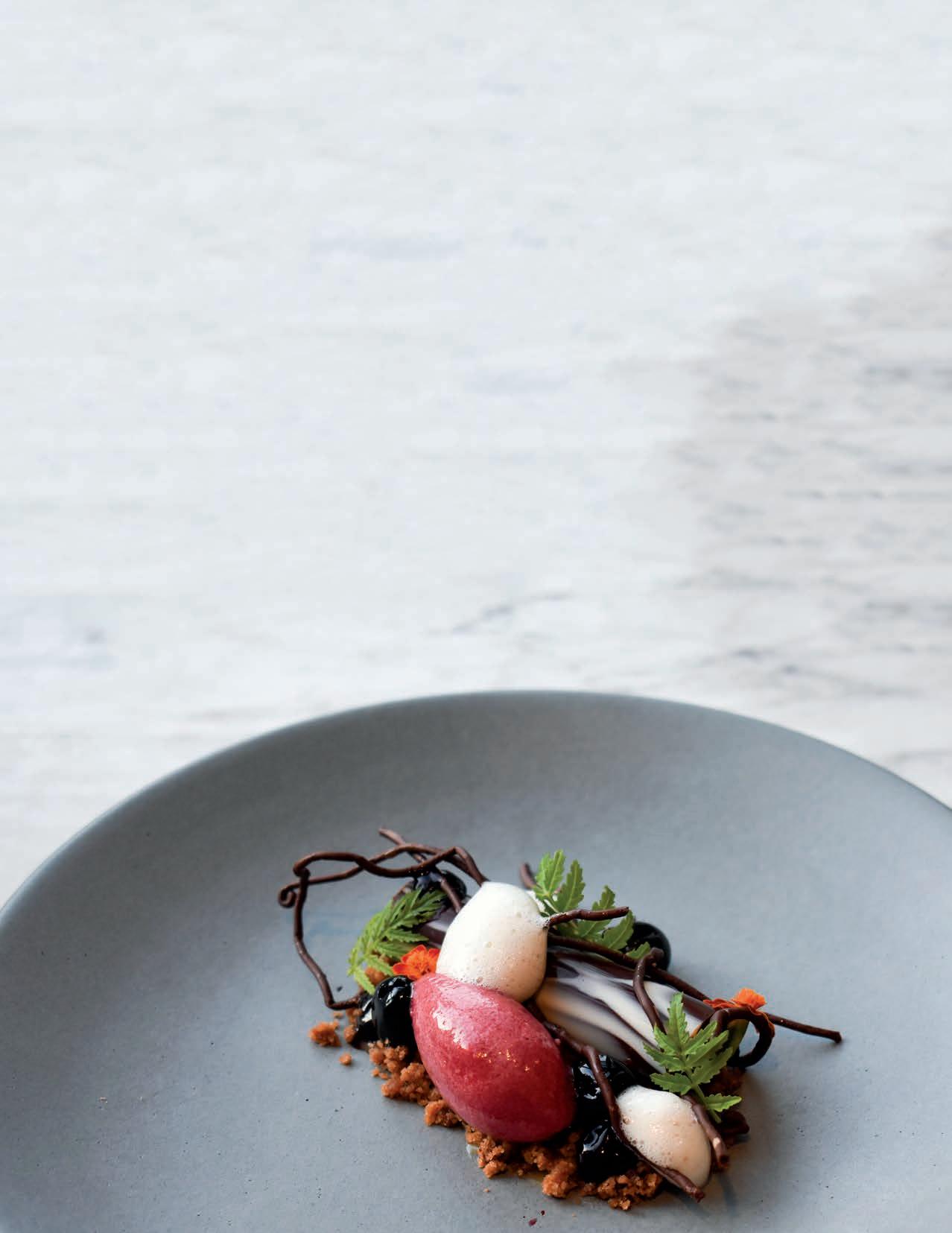
The Black Sesame Panna Cotta with ginger gelée, cucumber spheres, nori sponge, pomegranate foam, sesame sands and kuromitsu gel resembles a Japanese garden with unique shapes that create a visual stimulation and excite the palette.
Japanese cucumber is found in many sushi rolls, so Evans' challenge was how to capture the cucumber’s flavor, but change its texture. Cucumbers are juiced, calcium lactate is added and the juice is frozen in sphere molds. When frozen, the spheres are dropped in a warm solution of water and sodium alginate, which causes a chemical reaction and results in a membrane being formed around the frozen cucumber sphere. After the membrane is formed, the component is allowed to rest at room temperature, which allows the frozen cucumber sphere to thaw and revert to a liquid. The outer membrane remains intact and is reserved for plating.
Ginger — fibrous, acidic and pickled — is usually
paired with sushi. To create a new texture, raw ginger is juiced. Lemon juice is added for more acidity and curtail the spiciness. Gelatin and agar agar are included to slow down the melting when plated. The gelée is poured into a hotel pan and allowed to set. After it’s cooled, the gelée is cut into the square blocks.
A pink foam is made from pomegranate juice and soy lecithin with an immersion blender. Nori sponge is made with rehydrated nori, which is folded into a sponge cake base, baked, broken into pieces and dehydrated. Sesame sand is made from white sesame oil that’s blended with tapioca maltodextrin.
Gel dots on top of the panna cotta are made by combining kuromitsu, water and 1% agar. After it is boiled and cooled, the mixture is blended to create a smooth gel.
rob Benes is a chicago-based hospitality industry writer. he can be reached at robbenes@comcast.net.
wearechefs .com 39
2019 ACF National Awards Finalists
c ongratulations to the following finalists who will compete for national titles at ac F's 2019 n ational
c onvention in o rlando, a ugust 4-8.
Chef of the Year
Frank Costantino, Edd, CEC, CCE, CCa, aaC acF long island chapter


sCott sCHEiBlE, CEC chefs de cuisine association of St. louis inc

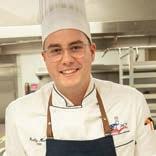
Pastr Y Chef of the Year


nguyEt nguyEn
acF philadelphia Delaware Valley chefs association
rysE sWanson
acF michigan chefs de cuisine association
s tudent Chef of the Year
daniEl HEss
acF chefs and cooks of the catskill mountains
HitoMi toMoBE
acF michigan chefs de cuisine association
CHarlEs FiguEroa, CEC acF Skyline chefs association of Virginia


CHiEF PEtty oFFiCEr Frida karani

u.S. navy acF nation's capital chefs association
rEilly MEEHan, CEC acF San Francisco chapter


MElinda Wilkins, CEPC


acF coastal Virginia chapter
kurt lECHnEr, CEPC
acF chefs & culinarians of San Diego
EMMa raE
El-Farra acF Beehive chefs chapter inc.
lanCE CPl. CHristoPHEr sanCHEz

u.S. marine corps
dEvin agosto
acF Southwestern Virginia chapter
40 ncr | m ay/June 2019 | Competition Winners |
Chef e du C ator of the Year
sCott stEinEr, CCa, aaC acF of Greater Buffalo new york

JoHn sCHoPP, CEC, CEPC, CCE, CCa, aaC acF Southwestern Virginia chapter
rudy kloEBlE, CEC acF chefs & culinarians of San Diego



Joanna Bryant Texas chefs association

gE or g E o ’ Pal E ni C k, CEC, CCE, aa C , H o F acF rhode island chapter
JEFFrEy rotz, CEC, CCE, aaC acF Gulf to lakes chefs & cooks association, inc.


lEnard ruBin, CEC, CCa acF chef's association of arizona, inc.


JoHn FolsE, CEC, aaC, HoF, HBot The acF of Greater Baton rouge

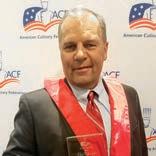
riCHard HoFFMan, Jr., CEC, CCa, aaC acF Greater Baltimore chapter inc.

CHristoPHEr MCCook, CEC, aaC acF atlanta chefs association, inc.
tuan raPHaEl, CEC
acF chef's association of arizona, inc.
Brian BEland, CMC acF michigan chefs de cuisine association
wearechefs .com 41
dr L .J. Minor Chef Professiona L is M a w ard
h er M ann G. r us C h Chef's a C hieve M ent a w ard
s tudent t ea M Cha MP ionshi P

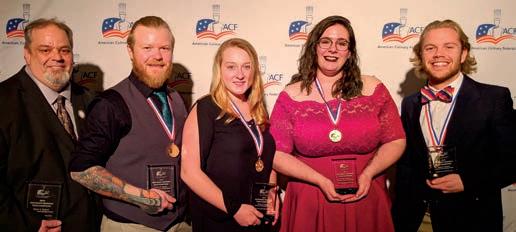








42 ncr | m ay/June 2019 | Competition Winners |
Joliet Junior college/Acf louis Joliet chapter
Asheville buncombe technical community college/ western nc culinary Association of the Acf
Acf chapter bay Area chefs Assoc. of oregon/ oregon coast culinary institute
Acf long island chapter/ culinary institute of new york at Monroe college
fort Drum, ny, Military student team
Acf honolulu chapter/kapiolani community college
hAcc, central pennsylvania's community college & members of Acf harrisburg chapter
Utah valley University culinary Arts institute
Acf southwestern virginia chapter
culinary institute of Michigan at baker college
Baron h . Ga L and Cu L inar Y Kno w L ed G e Bow L
ACF National Convention: o rlando
August 4-8, 2019 • Marriott World Center
An exciting lineup of topics of interest to chefs in every sector of the foodservice industry awaits at ACF National Convention: Orlando, including these trending culinary subjects...
Mastering food and wine pairing
Seminar with Craig Youdale and Peter Rod
Explore the cause and effect rules of pairing, while understanding the science that brings that pairing together to send your food and wine choices to a new level of excellence at your business or restaurant.
sustainability/food waste
fresh f lavors
Mega trend: plant forward cuisine
Panelists include Nina Curtis, Fran Costigan, Francis Gonzales
immersive Dining
Educational Demo with Richie Farina
Create a sense of “place” with your dishes and in turn you can create an experience for the diner.
earth to table: Defining the next frontier of local cuisine
Panelists include Ryan Manning, Jacob Wright, Keith Sarasin, Kendall Dix
from wasted to wanted: Using culinary innovation to Design waste out of the food system
Main Stage Presentation
Adam Kaye, The Spare Food Co.
Chef Kaye will educate and inspire by curating a delicious journey into the unseen and under-appreciated to rediscover the lost culinary, nutritional, financial and environmental value in our kitchens.
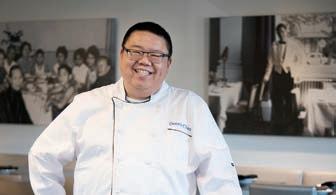
chef and farmer: taking “plant forward” a step further
Main Stage Presentation
Farmer Lee Jones and Jamie Simpson, The Culinary Vegetable Institute
This session will underscore the chef’s role as an educator who can spread the message that a plant based diet is only as healthy as the plants on the plate, and that vegetables can be used from root to tip with zero waste.
women in c ulinary leadership
symposium spotlight speaker
Elle Simone Scott, Women Leaders Panel, SheChef Inc.; America’s Test Kitchen

the value of Mentorship
Lindsay Ofcacek, Managing director of the LEE Initiative
Actionable next steps
Panelists include Stephanie Charns, CSCE, CWPC, Leah Sarris, Amy Sins, Allysun Selick, Bev Shaffer, Susanne Ebacher-Grier, Tracy Lorenz; Chandra Ram, Moderator
blazing your culinary trail Seminar with Jennifer Booker
This session will discuss the evolution and growth of the food service arena, take a long hard look at why traditional culinary careers don’t always work for women, and outline steps to become a trailblazer to your dream job.

A fine line
Joanna James, Zoel Productions and the MAPP Campaign
hip Asian comfort food
Educational Demo with Dennis Chan
United in food: women leader s o f today and tomorrow, August 8
Clips of the film “A Fine Line” will accompany related discussion led by Joanna James, its director and producer.
See more and register today at acfchefs.org/convention.
wearechefs .com 43 | Events |
2019 ACF National Convention: Sponsors





Marriott World Center
August 4 - 8, 2019





INSPIRATION
e xecutive c hef
c hef D e c uisine
as of April 15, 2019
patissier Sponsors
s ous c hef s a ucier
nCr Quiz
May/June 2019
By LeeAnn Corrao
According to research done by Restaurant Opportunities Centers United, what percentage of people who work in the restaurant industry lack paid sick days?
a. 77%
b. 85%
c. 87%
d 92%
Honey Butter Fried Chicken in Chicago has found that providing health benefits to their employees has been detrimental to the success of their business.
a. Tr ue
b. Fa lse
What is aush?
a. A staple of Persian cuisine
b. A savory porridge


c. A festive soup
d. A n aromatic dessert
Why are dates popular in desert countries?
a. Their high sugar content is a source of quick energy
b. They are found in abundance
c. They have religious associations
d. Both A and C
Which of the following is not a reason chefs have been evolving plated desserts over the past several years?
a. The financial part of dessert is difficult
b. Dessert has become an anytime occasion
Which chef likes to transform savory dishes into something sweet and present items that look simple but hide impressive surprises?
a. Ryan Boya
b. Jessica Scott
c. Dallas Wynne
d. R oss Evans
c. Plated desserts now need eye-catching designs as well as great flavor
d. The vegan movement has forced chefs to use new ingredients

What is Redwood Shores’ The Blend?
a. A blend of spices used on veggie burgers
b. A blend of vegetables used to make burger patties
c. Burgers with a blend of beef and mushrooms
d. Burgers with a blend of turkey and vegetables
Najmieh Batmanglij is the author of many books on Persian cuisine.
a. Tr ue
b. Fa lse
MontanaMex supports what other organization through donations and setting up tents at events?
a. Challenged Athletes Foundation
b. Project Include
c. International Disability Alliance
d. Athlete Ally
What flavor profile does Ross Evans incorporate into his desserts?
a. Japanese
b. Chinese
c. R ussia
d. In dian
See the rest of the questions, finish the quiz and earn 4 CEHs toward your certification on ACF’s new Online Learning Center at acfchefs.org/learn.
wearechefs .com 45 | Quiz |
Difficult to Master
By Heather Henderson
The Certified Master Chef Exam was the result of extensive planning by ACF leaders in the 1980s, with the goal of creating a real, measurable exam for those that considered themselves “master chefs.” The guidelines were developed to be very difficult, ensuring only the most skilled and dedicated chefs were able to pass. The exam was announced by thenCertification Chairman Jeff Larson, CEC, AAC, in a 1980 issue of the National Culinary Review. The exam was initially planned to have an age requirement and to only be available to AAC members, but those restrictions were quickly removed due to fears that it would severely limit the program.
According to the NCR archives, the first exam was set for March 1981 and would take ten full days to complete. But the March 1981 issue of NCR announces that the first CMC exam was to be held in May.
The next mention comes in July, with a column by Larson under the headline “IS THE MASTER CHEF PROGRAM TOO CHALLENGING?” The column is short on details and it leaves readers to wonder whether the exam ever happened.

According to Chef Larson, still an active ACF member today, they struggled to find enough people to sign up for the exam. Would-be CMC candidates appeared to be wary of the rigors of the exam as opposed to motivated or inspired.
Finally, in September of 1981, eight candidates traveled to the Culinary Institute of America in Hyde Park, New York to take the test. After ten days, each lasting nearly 14 hours, chefs Milos Cihelka, Byron J. Bardy, Anton Flory, Dieter Kiessling and Richard Schneider all earned the honor of become the world’s first Certified Master Chefs.
Today there are 67 CMCs with this year’s addition of Timothy Bucci, CMC, CCE. Observers crowded the viewing area and watched live as Chef Bucci cooked, day after day. It's safe to say that many in that audience were taking notes, getting ready to take on the most difficult culinary exam in the world.

C M Y CM MY CY CMY K 46 ncr | m ay/June 2019 | A Look Back |







































































































































































 by Jocelyn Tolbert
by Jocelyn Tolbert
























 By Jody Shee
By Jody Shee
































































